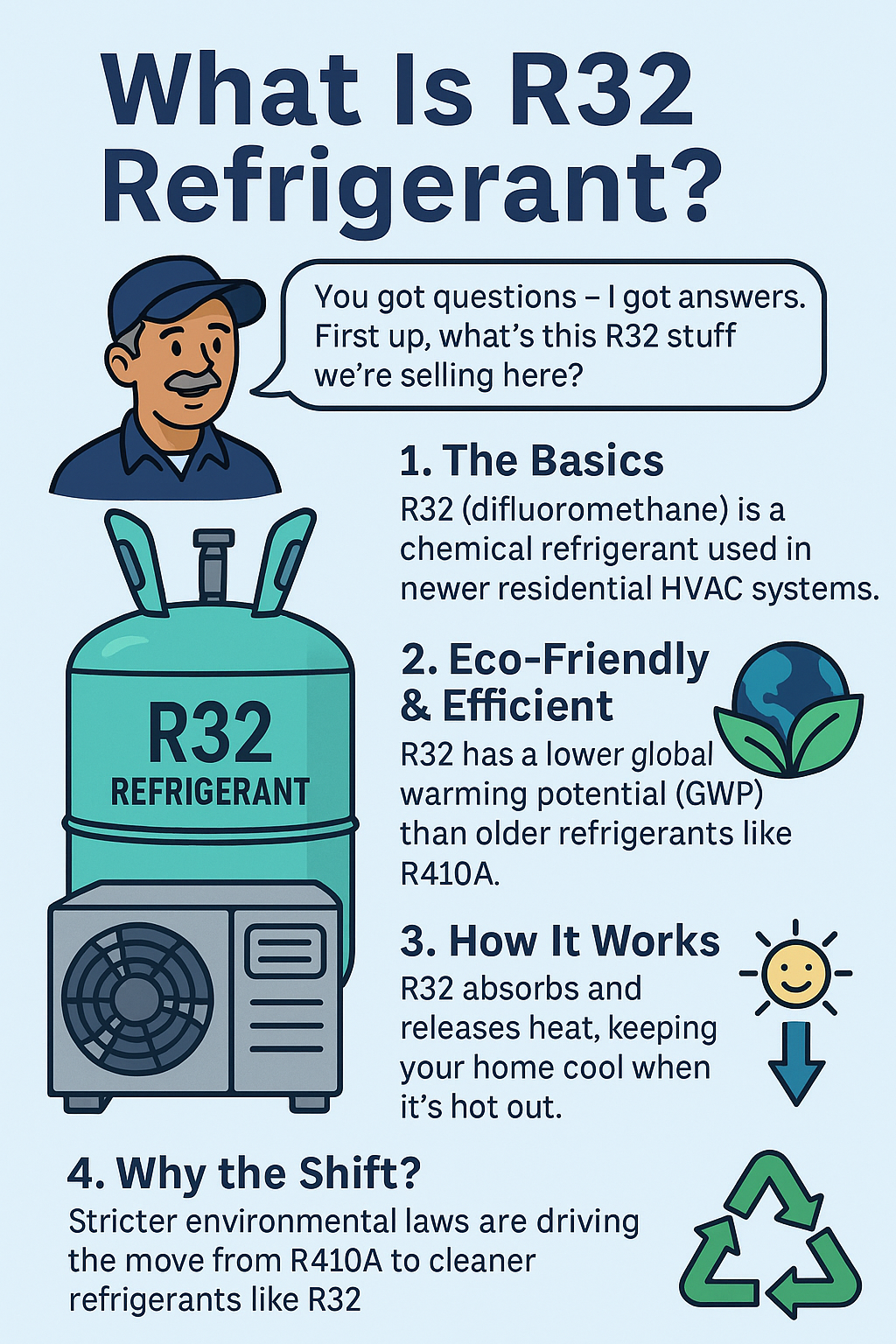Why This New Refrigerant Might Be the Best Thing to Happen to Your Next Air Conditioner
“If you’re replacing your AC system or shopping around for a new condenser, you’ve probably seen ‘R32’ on the spec sheet. Let’s break down what it is — and why it matters.”
🧊 What Is R32, Anyway?
R32 (difluoromethane) is a next-generation refrigerant used in residential and commercial HVAC systems. It’s part of the HFC (hydrofluorocarbon) family — same as R410A — but it packs a better environmental punch.
-
Chemical Name: CH₂F₂
-
ASHRAE Safety Classification: A2L (low toxicity, mildly flammable)
-
Global Warming Potential (GWP): 675 (that’s 1/3 of R410A’s 2088)
-
Ozone Depletion Potential (ODP): Zero
So what does that mean for you?
“It means you’re getting a more eco-friendly unit that still cools like a beast. And it helps future-proof your system against upcoming regulations.”
♻️ R32 vs. R410A: Efficiency and Environmental Impact
Let’s put it head to head.
| Feature | R32 | R410A |
|---|---|---|
| GWP | 675 | 2088 |
| ODP | 0 | 0 |
| Efficiency | Higher (up to 10% better) | Standard |
| Charge Amount | Less refrigerant needed | More refrigerant |
| Flammability | Mild (A2L) | Non-flammable |
| Heat Transfer | Faster | Slower |
Bottom line: R32 units tend to be more efficient, smaller, and greener.
👉 Learn more from the U.S. EPA SNAP R32 Fact Sheet
👉 Comparison data available from Daikin’s Global R32 Initiative
🔥 “But Tony… Is R32 Safe?”
Short answer: Yes.
Long answer: Like anything in HVAC, it’s safe when installed and handled properly. R32 is classified as A2L — low toxicity, mildly flammable. It’s not going to explode. But it does require technicians to follow updated guidelines when charging, recovering, or transporting it.
“If you’re having a certified HVAC tech do the install — or you’re DIY-ing with real training — you’ll be just fine.”
For safety standards, see ASHRAE's Refrigerant Safety Classification (look for ASHRAE Standard 34).
📦 Why Manufacturers Are Switching to R32
By 2025 and beyond, regulations in North America and Europe are pushing for lower GWP alternatives. R32 is already widely adopted in Asia and Australia, and U.S. brands are catching up fast.
Some major benefits for manufacturers and homeowners:
-
Easier to recycle (it’s a single-component refrigerant)
-
Lower cost per pound
-
Increased energy efficiency ratings (SEER2)
-
More compact system designs
“In plain English: your system will run cheaper, last longer, and pollute less.”
🏠 Should You Buy an R32 AC Unit?
If you’re buying new in 2025 or later, R32 is your best bet — especially for residential air conditioning. It’s smart, safe, and future-ready.
✔️ More efficient
✔️ Less environmental impact
✔️ Compatible with many new residential systems
✔️ Better long-term ROI
Just make sure:
-
You pair it with the right indoor coil
-
Your installer knows how to handle A2L-rated refrigerants
-
You follow proper warranty registration steps
👇 Ready to See Your Options?
“If you’re convinced R32 is the way to go — and it should be — I’ve got a collection ready for you to browse.”
🔗 Explore Our R32 AC Condensers »
In the next topic we will read about: R32 vs R410A: Which Is Better for Your AC?







